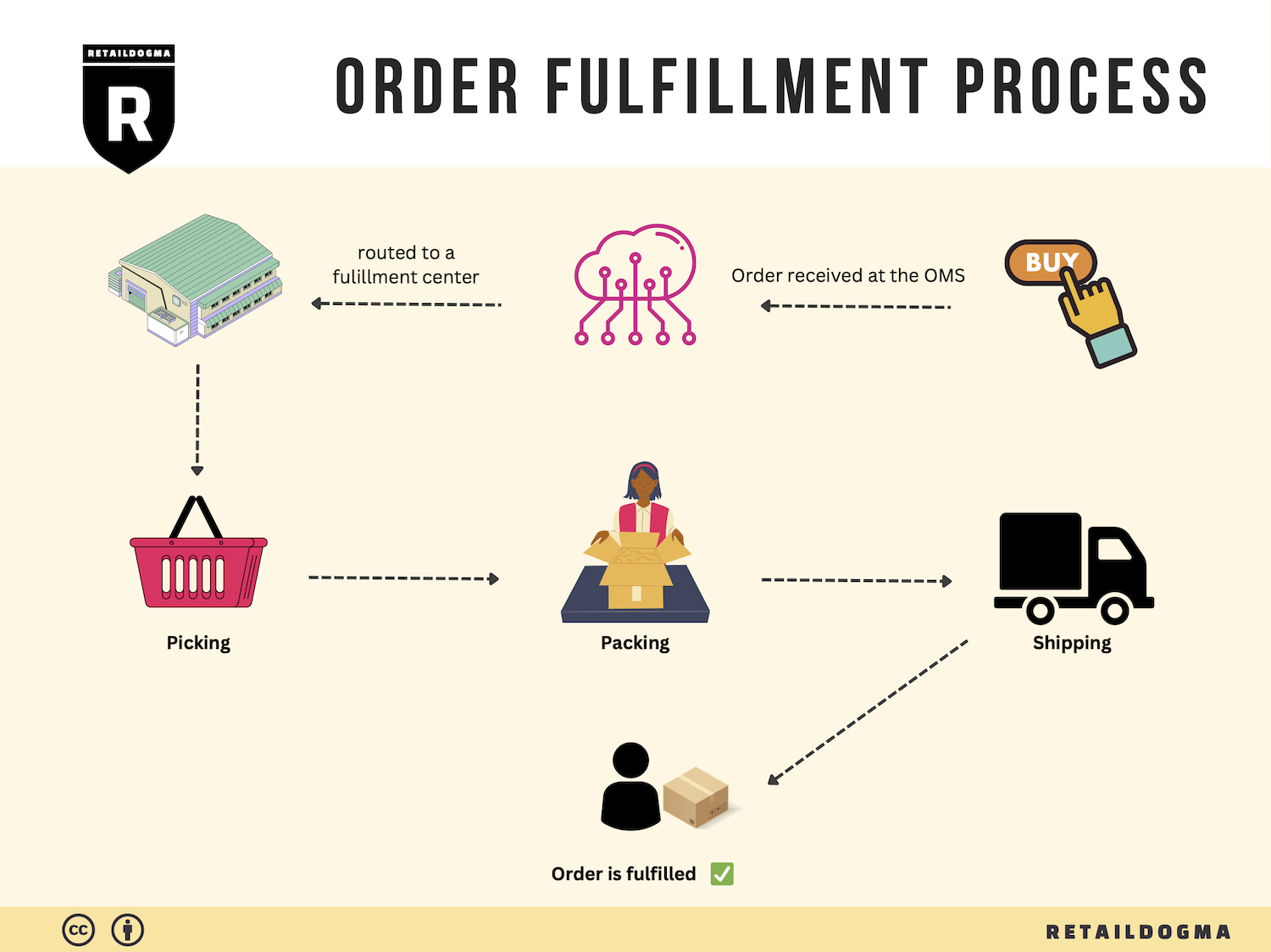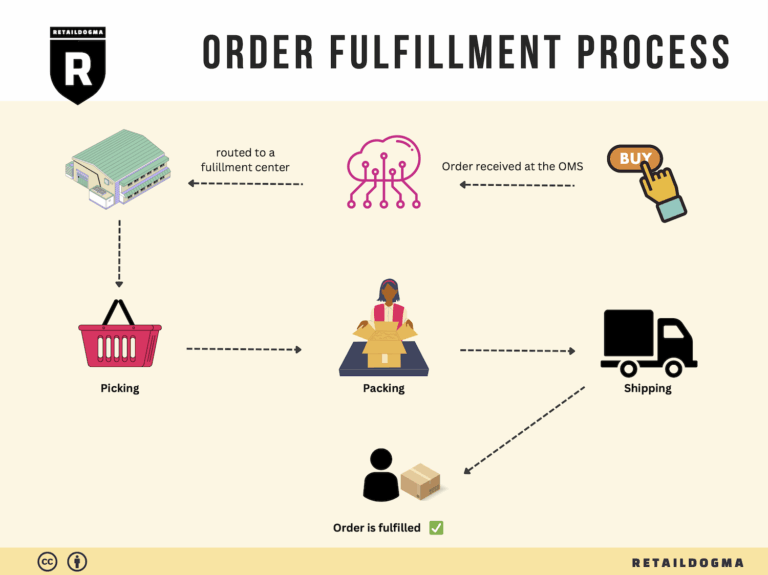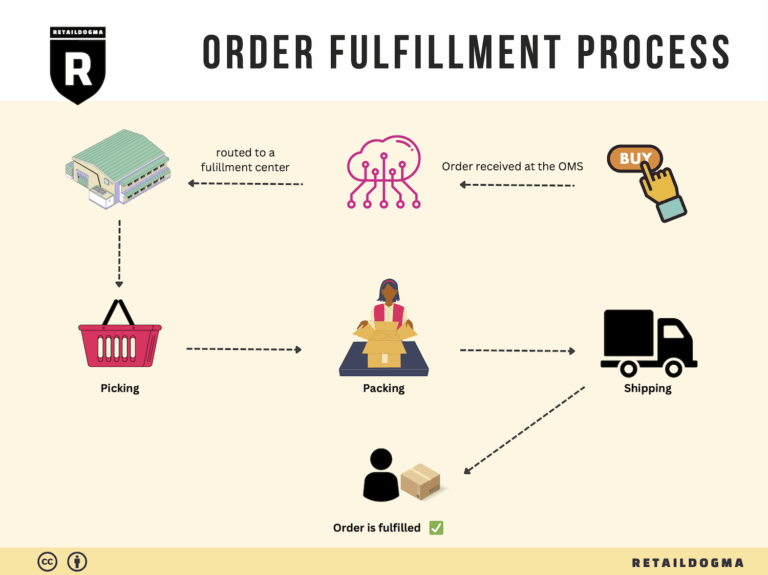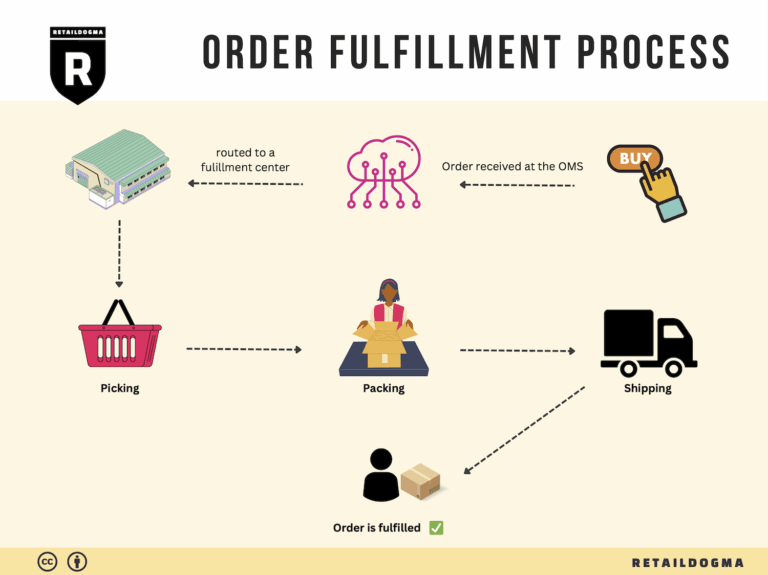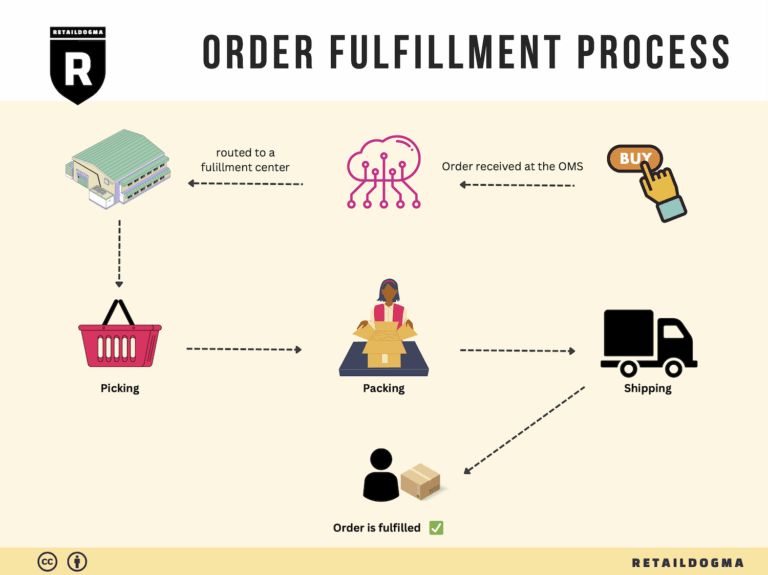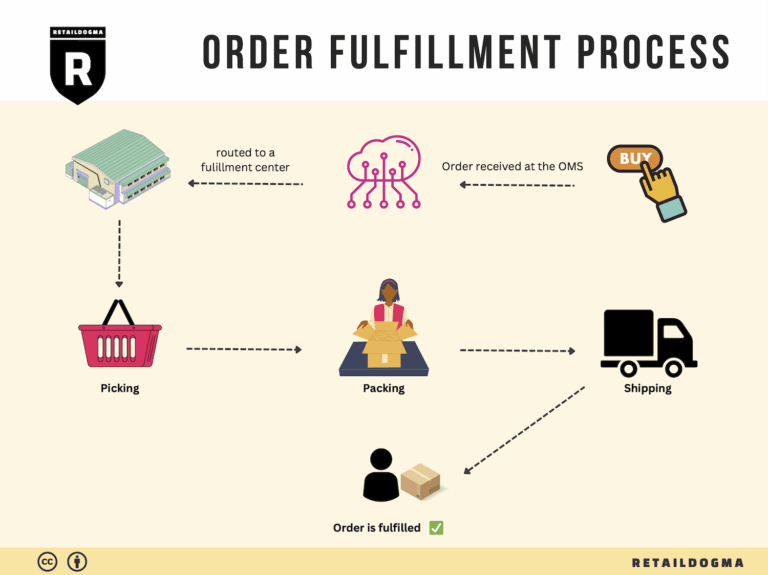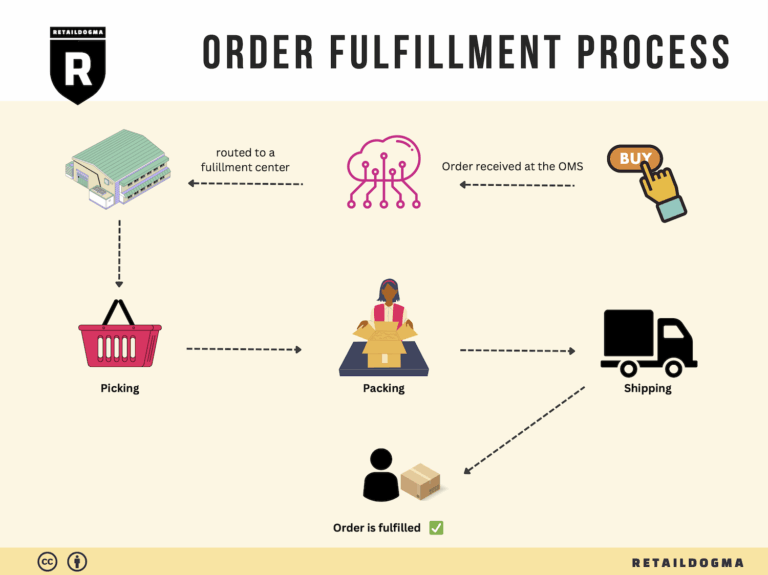How Order Fulfillment Works: A Step-by-Step Guide for Businesses
What is E-commerce Fulfillment? An Introduction for Growing Businesses
Introduction to E-commerce Fulfillment
As an e-commerce business owner, the excitement of scaling your operations can quickly turn into a daunting challenge when it comes to fulfilling orders. The process of packing and shipping products can become overwhelming, especially as order volumes increase. Timely delivery and efficient logistics are crucial to maintaining customer satisfaction, but managing these aspects can divert your focus from growth and innovation.
At its core, fulfillment is simply the process of getting a product from your warehouse to your customer’s doorstep. It encompasses everything from receiving inventory to picking, packing, and shipping orders. Understanding how this process works is essential for any growing online business aiming to scale efficiently and effectively.
This guide will delve into the various fulfillment models available to e-commerce businesses, including Third-Party Logistics (3PL) and Fulfillment by Amazon (FBA). Each model has its own advantages and can significantly impact your operational efficiency and bottom line. We will explore the core services provided by fulfillment centers, which typically include inventory management, order processing, and shipping solutions.
Choosing the right fulfillment partner is a critical decision that can determine the success of your logistics strategy. This guide will provide insights on what to look for in a partner, including their technology capabilities, service offerings, and how they align with your business needs. Furthermore, we will cover pricing structures associated with fulfillment services to help you understand the cost implications and how to budget effectively.
The ultimate goal of this guide is to empower your business to make informed decisions about its logistics and fulfillment strategies. By equipping you with the knowledge to navigate the complexities of e-commerce fulfillment, we aim to help you streamline your operations, enhance customer satisfaction, and drive growth.
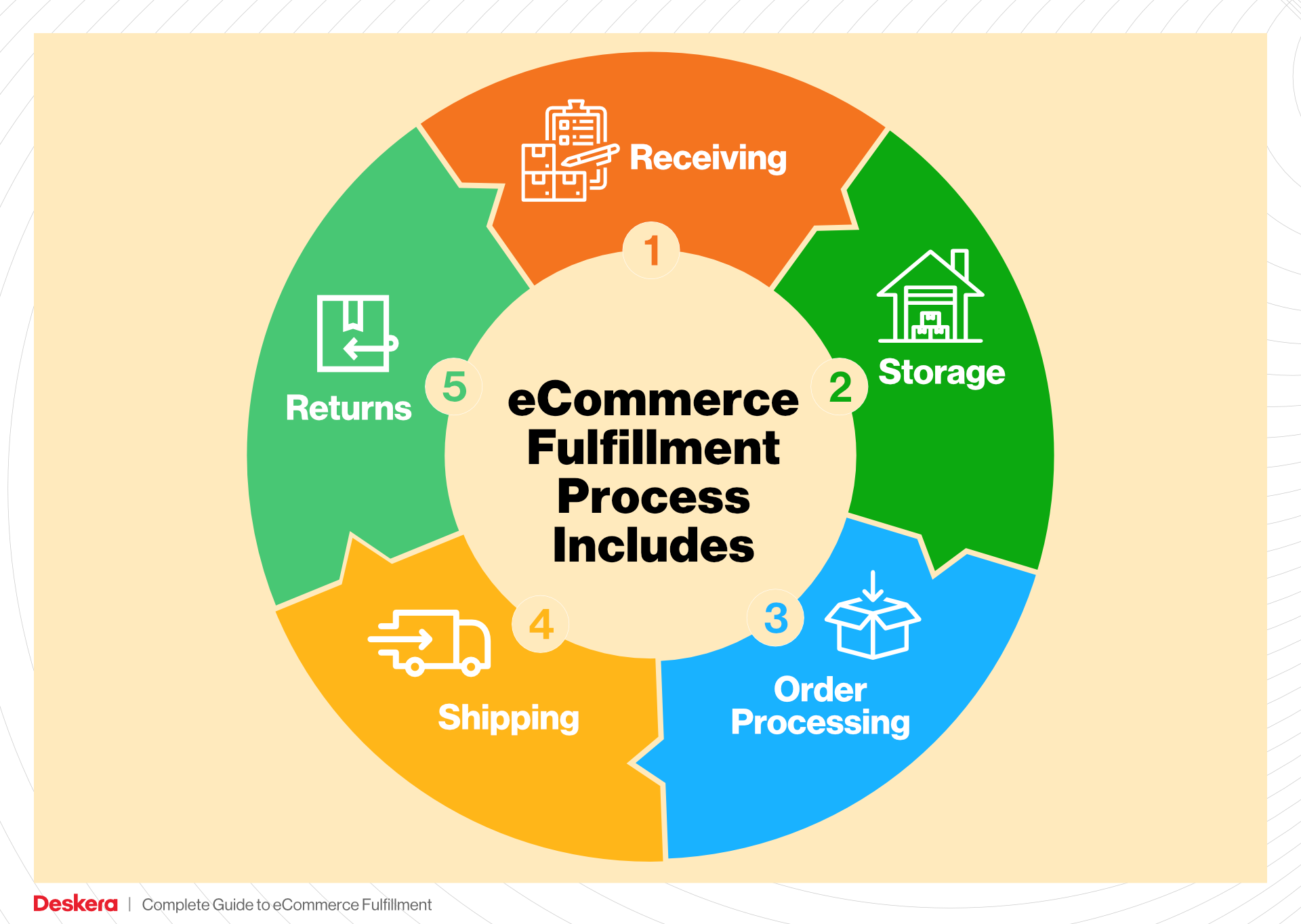
Whether you are just starting or looking to refine your fulfillment processes, this comprehensive guide will serve as a valuable resource in your journey toward scaling your e-commerce business successfully.
What You’ll Learn In This Guide
- What is E-commerce Fulfillment? An Introduction for Growing Businesses
- The Order Fulfillment Process: From ‘Buy’ Button to Customer’s Door
- Comparing Fulfillment Models: In-House vs. 3PL vs. Dropshipping
- A Deep Dive into Amazon FBA: Pros, Cons, and Who It’s For
- Core Services Offered by Fulfillment Centers
- How to Choose a Fulfillment Partner: A 6-Point Checklist
- Understanding Fulfillment Pricing: A Breakdown of Common Fees
- Frequently Asked Questions (FAQs) about Fulfillment
- Conclusion: Is Outsourcing Fulfillment the Right Move for Your Business?
- Important Disclaimer
The Order Fulfillment Process: From ‘Buy’ Button to Customer’s Door
1. Receiving Inventory
The order fulfillment process begins with receiving inventory at the fulfillment center. This step is crucial as it lays the foundation for all subsequent activities. When products arrive at the facility, they go through a thorough inspection to ensure quality and accuracy. The received items are logged into the inventory management system, often using Stock Keeping Units (SKUs), which are unique identifiers for each product. This systematic approach ensures that every item is accounted for and can be easily tracked throughout the fulfillment process.
Effective inventory receiving is vital because it minimizes errors and discrepancies that can lead to stockouts or delays in order fulfillment. By accurately logging each product and its corresponding SKU, businesses can maintain an organized inventory, which is essential for efficient operations. Additionally, timely receiving helps in managing lead times and ensures that products are available for customers as soon as they place an order.
2. Warehouse Storage
Once inventory is received, it is stored within the fulfillment center until orders are placed. This step involves strategically organizing products in designated storage areas. The layout of the warehouse can vary, but it is typically designed to facilitate easy access and efficient space utilization. Products may be organized by category, size, or demand frequency, depending on the fulfillment center’s operational strategy.
The importance of effective warehouse storage cannot be overstated. Proper organization ensures that items can be quickly located when orders come in, reducing the time spent searching for products. Additionally, a well-structured storage system helps prevent damage and loss of inventory. Utilizing technology, such as barcode scanning and inventory management software, allows for real-time tracking of stock levels and locations, which is crucial for maintaining operational efficiency.
3. Order Picking
Order picking is the process of retrieving the right items from storage to fulfill customer orders. When an order is placed, the fulfillment center generates pick lists, which detail the specific items and quantities required. This information is crucial for pickers, who must ensure they select the correct products in a timely manner.

The efficiency of the picking process directly impacts the overall speed of order fulfillment. Automated systems, including robots and conveyor belts, are increasingly being integrated into fulfillment centers to enhance accuracy and reduce labor costs. By optimizing the picking process, businesses can improve order accuracy and customer satisfaction. The faster and more accurately orders are picked, the quicker they can be processed and shipped to customers, which is especially important in today’s fast-paced e-commerce environment.
4. Order Packing
After items are picked, they move to the packing stage. Here, associates carefully pack the products to ensure they are secure for shipping. This involves scanning items to verify accuracy and using appropriate packaging materials to protect them during transit. Advanced packing systems may recommend the optimal box size and measure the necessary amount of tape, minimizing waste.
Packing is a critical step in the fulfillment process because it directly affects the condition in which products arrive at the customer’s doorstep. Proper packing prevents damage and ensures that items are delivered as expected, which is essential for maintaining customer trust and satisfaction. Efficient packing processes can also reduce shipping costs by optimizing package dimensions and weight, contributing positively to the bottom line.
5. Shipping & Delivery
The final step in the order fulfillment process is shipping and delivery. Once orders are packed, they are labeled and sorted based on their destination. Fulfillment centers like Amazon utilize advanced technologies such as SLAM (scan, label, apply, manifest) machines to streamline this process. These systems enable rapid labeling and quality checks, ensuring that packages are correctly prepared for transit.
Shipping is a pivotal aspect of fulfillment, as it determines how quickly customers receive their orders. Fulfillment centers often work with various carriers and utilize a diversified fleet, including planes, trucks, and vans, to optimize delivery times based on customer expectations. For example, orders eligible for Amazon Prime are prioritized to meet the two-day delivery guarantee. Efficient shipping processes not only enhance customer satisfaction but also improve operational efficiency by reducing transportation costs and ensuring timely deliveries.
In summary, understanding each step of the order fulfillment process—from receiving inventory to shipping and delivery—enables e-commerce businesses to optimize their operations and scale effectively. By leveraging technology and best practices in each phase, businesses can enhance their fulfillment capabilities, ultimately leading to improved customer experiences and increased sales.
Comparing Fulfillment Models: In-House vs. 3PL vs. Dropshipping
Fulfillment Model Comparison
| Model | Who Handles Inventory | Best For (Business Stage) | Key Advantage | Key Disadvantage |
|---|---|---|---|---|
| In-House Fulfillment | Business Owner | Established Businesses | Complete control over operations and inventory | High overhead costs and resource-intensive |
| Third-Party Logistics (3PL) | Third-Party Provider | Growing Businesses | Scalability and access to expertise in logistics | Less control over inventory and potential service variability |
| Dropshipping | Supplier | Startups and Small Businesses | Low upfront investment and minimal risk | Lower profit margins and reliance on suppliers |
In-House Fulfillment
In-house fulfillment involves managing the entire order fulfillment process within the business itself. This means the company is responsible for inventory management, order processing, packing, and shipping. Typically, this model suits established businesses that have the resources, infrastructure, and volume of orders to justify the investment. The key advantage of in-house fulfillment is the complete control it offers over the entire supply chain. Businesses can ensure quality, handle customer service directly, and adapt quickly to changes in demand or inventory needs. However, this model also comes with significant disadvantages, notably high overhead costs related to warehousing, staffing, and logistics management. For many businesses, especially those just starting out or with fluctuating order volumes, the resource intensity of in-house fulfillment can become a burden, diverting focus from core business activities.
Third-Party Logistics (3PL)
Third-party logistics (3PL) is a model where businesses outsource their logistics and fulfillment needs to specialized providers. These providers handle inventory storage, order processing, packing, and shipping, allowing businesses to focus on sales and marketing. This model is particularly beneficial for growing businesses that may not have the capital or expertise to manage logistics effectively. The key advantage of 3PL is scalability; as order volumes increase, businesses can easily scale their logistics operations without significant upfront investment in infrastructure. Additionally, 3PL providers often have established relationships with shipping carriers, enabling more favorable shipping rates and faster delivery times. However, outsourcing fulfillment also means relinquishing some control over inventory management and customer service, which can lead to inconsistencies in service quality if not carefully managed. Businesses must choose their 3PL partners wisely to align with their operational standards and customer expectations.
Dropshipping
Dropshipping is a fulfillment model where the retailer does not hold inventory but instead transfers customer orders directly to the supplier, who then ships the products to the customer. This model is ideal for startups and small businesses that want to minimize upfront investment and risk. The primary advantage of dropshipping is the low barrier to entry; businesses can start selling without the need to invest in inventory or warehousing. It allows for a diverse product offering without the financial burden of unsold stock. However, dropshipping also comes with significant drawbacks. Profit margins are typically lower than other fulfillment models, as suppliers take a cut of the sales. Moreover, the retailer relies heavily on the supplier for inventory management and shipping, leading to potential issues with stock availability and shipping times. This dependency can result in poor customer experiences if the supplier fails to deliver on time or maintains inconsistent quality. As such, while dropshipping can be an attractive option for new businesses, it requires careful supplier selection and management to ensure customer satisfaction.
In conclusion, choosing the right fulfillment model is crucial for e-commerce businesses looking to scale. Each model has its unique advantages and disadvantages, and the decision should align with the company’s stage, resources, and growth strategy. Understanding these fulfillment options can empower business owners to make informed decisions that contribute to their long-term success.
A Deep Dive into Amazon FBA: Pros, Cons, and Who It’s For
Understanding Fulfillment by Amazon (FBA)
Fulfillment by Amazon (FBA) is a service that allows e-commerce sellers to store their products in Amazon’s fulfillment centers. When customers place orders for these products, Amazon takes care of the storage, packing, shipping, and even customer service, enabling sellers to focus on growing their businesses rather than managing logistics.
How FBA Works
-
Inventory Storage: Sellers send their inventory to Amazon fulfillment centers, where the products are stored until sold. This process can significantly reduce the burden of warehousing for small and medium-sized businesses.
-
Order Processing: When a customer places an order for a product available through FBA, Amazon automatically processes the order. This includes picking the item from the warehouse, packing it efficiently, and preparing it for shipment.
-
Shipping: Amazon uses its extensive logistics network to ship the product directly to the customer. This often includes expedited shipping options for Prime members.
-
Customer Service: Amazon handles all customer service inquiries related to FBA orders, including returns and refunds, allowing sellers to maintain a high level of customer satisfaction without the hands-on management.
-
Multi-Channel Fulfillment: Sellers can also use FBA to fulfill orders from other sales channels, not just Amazon. This provides flexibility and consolidates shipping operations under one umbrella.
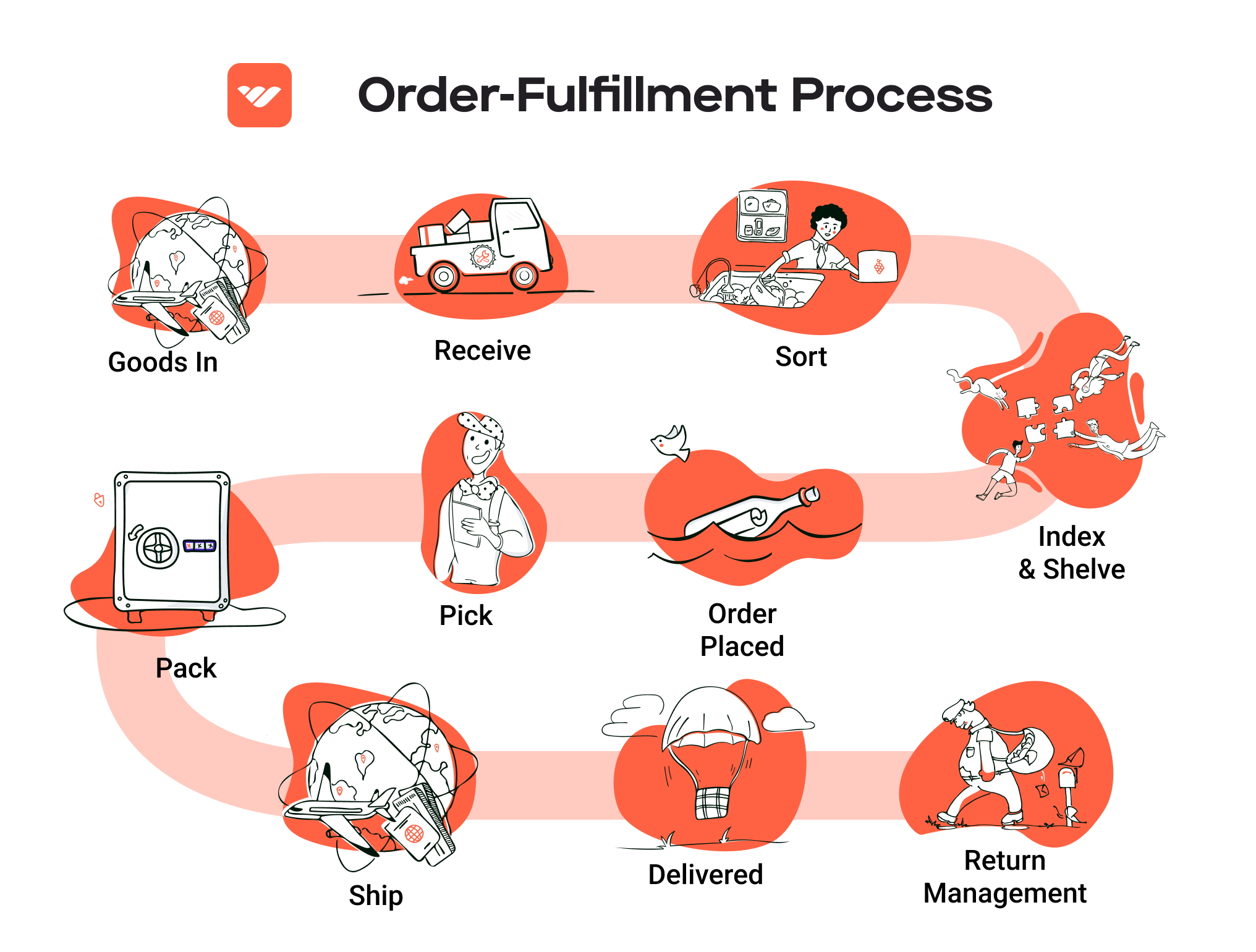
Pros of Using FBA
-
Prime Eligibility: Products fulfilled through FBA are eligible for Amazon Prime, which can significantly increase sales. Prime members often prefer products that offer fast, free shipping, leading to higher conversion rates for FBA items.
-
Customer Trust and Credibility: Having the Amazon brand behind your products can enhance customer trust. Shoppers are more likely to purchase from sellers using FBA due to Amazon’s reputation for reliability and customer service.
-
Scalability: FBA allows sellers to scale their operations without needing to invest in additional warehousing or logistics. As demand increases, sellers can send more inventory to Amazon, and the fulfillment center will handle the rest.
-
Automated Logistics: The automation of order processing, packing, and shipping through Amazon’s advanced systems saves time and minimizes errors, allowing sellers to focus on marketing and product development.
-
Multi-Channel Fulfillment: Sellers can leverage FBA to fulfill orders from their websites or other online marketplaces. This centralizes inventory management and simplifies logistics.
Cons of Using FBA
-
High Fees: While FBA can save time, it comes at a cost. Sellers must pay for storage, fulfillment, and additional services, which can cut into profit margins. It’s crucial to analyze whether the benefits outweigh these costs for your particular business model.
-
Strict Inventory Rules: Amazon has specific policies regarding inventory management, including limitations on the types of products that can be stored and how long they can remain in fulfillment centers. Failure to comply can result in additional fees or inventory removal.
-
Commingling Risks: With FBA, sellers’ products may be stored alongside those from other sellers. This commingling can pose risks, such as receiving returns for products that were not originally yours or quality control issues if another seller’s items are defective.
-
Loss of Control: Once products are sent to Amazon, sellers relinquish some control over the fulfillment process. This can be concerning for those who want to maintain direct oversight of their logistics and customer service.
-
Inventory Management Challenges: Managing stock levels can be tricky when using FBA, as sellers must anticipate demand and avoid both stockouts and overstock situations. Inadequate inventory management can lead to lost sales or increased storage fees.
Who is FBA Best For?
Fulfillment by Amazon is particularly beneficial for small to medium-sized e-commerce businesses looking to scale quickly without the overhead of managing logistics. It suits sellers who:
-
Want to Reach a Larger Audience: If your business aims to tap into Amazon’s vast customer base, FBA provides an excellent opportunity to gain visibility and sales.
-
Prefer a Hands-Off Approach to Fulfillment: Entrepreneurs who want to focus on product development and marketing rather than order fulfillment will find FBA advantageous.
-
Sell High-Volume Products: Businesses that have consistent sales and can manage the associated fees will benefit from the efficiencies of FBA.
-
Seek Fast Shipping Options: If your products are suitable for Prime customers, using FBA can significantly boost sales due to the appeal of fast, free shipping.
-
Have a Diverse Product Range: Sellers with multiple products across various categories can leverage FBA’s multi-channel fulfillment to streamline operations.
In conclusion, while Fulfillment by Amazon offers many advantages, it is essential to weigh these against the potential downsides. Businesses should conduct a thorough analysis of their specific needs, product types, and sales strategies before deciding whether FBA is the right choice for them.
Core Services Offered by Fulfillment Centers
Inventory Management & Warehousing
Inventory management and warehousing form the backbone of any successful e-commerce operation. Fulfillment centers like Amazon MDW6 provide robust inventory management systems that help businesses efficiently track and manage their stock levels. This includes receiving products, storing them in organized warehouse environments, and maintaining accurate inventory counts through advanced technology such as barcode scanning and inventory management software.
Benefits:
– Efficiency in Stock Management: By utilizing automated systems, fulfillment centers ensure that inventory levels are consistently updated in real time. This minimizes the risk of stockouts or overstocking, which can lead to lost sales or increased holding costs.
– Space Optimization: Fulfillment centers are designed to maximize storage space, allowing businesses to store a larger variety of products without the need for additional warehouse space. This is particularly beneficial for small to medium-sized enterprises that may lack the capital to invest in their own warehousing solutions.
– Location Advantage: Many fulfillment centers are strategically located near major metropolitan areas, reducing shipping times and costs. This geographical advantage allows businesses to offer faster delivery options to their customers, enhancing satisfaction and loyalty.
Pick and Pack Services
The pick and pack process is a critical component of order fulfillment. In this stage, fulfillment center staff or automated systems retrieve the ordered items from storage (picking) and prepare them for shipment (packing). Amazon MDW6 employs a mix of technology and human labor to ensure accuracy and speed in fulfilling orders.
Benefits:
– Increased Accuracy: Fulfillment centers utilize advanced technology to minimize picking errors. Automated systems can bring items directly to pick stations, reducing the time workers spend searching for products and enhancing order accuracy.
– Scalability: As e-commerce businesses grow, so do their order volumes. Fulfillment centers can easily scale operations to accommodate spikes in demand, such as during holiday seasons or promotional events, without the need for businesses to hire additional staff.
– Cost-Effective Operations: By outsourcing picking and packing, businesses can reduce their operational costs. They avoid the expenses associated with managing in-house staff and warehouse facilities, allowing them to focus on core business functions like marketing and product development.
Kitting and Assembly
Kitting and assembly services offered by fulfillment centers involve assembling multiple products into a single package or preparing items for special promotions. For instance, if a business sells a gift set that includes various items, the fulfillment center can assemble these products into a single kit before shipping. This service is particularly useful for businesses that offer customized products or seasonal bundles.
Benefits:
– Enhanced Customer Experience: By providing kitting services, businesses can offer unique product bundles that appeal to customers looking for convenience. This can improve the overall shopping experience and increase average order value.
– Streamlined Operations: Outsourcing kitting and assembly to a fulfillment center allows businesses to streamline their operations. They can reduce the time and labor costs associated with assembling products in-house, freeing up resources to focus on other critical areas.
– Flexibility in Product Offerings: Kitting services enable businesses to quickly adapt to market trends by launching new product bundles without significant investment in additional labor or facilities. This flexibility can give businesses a competitive edge in the ever-changing e-commerce landscape.
Returns Management (Reverse Logistics)
Returns management, or reverse logistics, is the process of handling returned goods. Fulfillment centers like Amazon MDW6 offer comprehensive returns management services, which include receiving returned items, inspecting them, restocking them, or processing refunds. Efficient returns management is essential for maintaining customer satisfaction and loyalty.
Benefits:
– Improved Customer Satisfaction: A smooth returns process enhances the customer experience, as consumers appreciate hassle-free return policies. This can lead to increased trust and repeat business, essential for long-term success.
– Cost Reduction: By centralizing returns processing at a fulfillment center, businesses can reduce the costs associated with managing returns in-house. Fulfillment centers can handle the logistics of returns more efficiently, minimizing the time and labor required.
– Data Insights: Fulfillment centers track return data, providing businesses with valuable insights into product performance and customer preferences. This information can help businesses make informed decisions about inventory management, product quality, and marketing strategies.
In summary, partnering with a fulfillment center like Amazon MDW6 offers e-commerce businesses a comprehensive suite of services that streamline operations, enhance customer experiences, and ultimately contribute to scalable growth. By leveraging these core services, businesses can focus on their strategic objectives while ensuring efficient and effective fulfillment processes.
How to Choose a Fulfillment Partner: A 6-Point Checklist
Location & Warehouse Network
When selecting a fulfillment partner, the geographical location of their warehouses is crucial. A strategically located fulfillment center can significantly reduce shipping times and costs, enhancing customer satisfaction.
Why It Matters:
The closer your fulfillment center is to your target market, the faster your deliveries can be. This is especially important for businesses that promise quick shipping, such as those using services like Amazon Prime.
Questions to Ask:
– Where are your fulfillment centers located?
– How do you determine the best warehouse for shipping to my customers?
– Do you have plans for expanding your warehouse network in the near future?
Technology & Integrations
In today’s digital landscape, the technology used by your fulfillment partner can make or break your logistics operations. An efficient, user-friendly system can streamline inventory management, order processing, and shipping.
Why It Matters:
Advanced technology allows for real-time tracking, automated inventory management, and seamless integration with your existing e-commerce platforms. This not only saves time but also reduces the risk of errors.
Questions to Ask:
– What technology platforms do you use for order management and inventory tracking?
– Can your systems integrate with my e-commerce platform (e.g., Shopify, WooCommerce, Amazon)?
– Do you offer real-time tracking for both me and my customers?
Specializations (e.g., Cold Storage, Oversized Items)
Different businesses have unique product needs. Some may require cold storage for perishables, while others might deal with oversized or fragile items that require special handling.
Why It Matters:
Choosing a fulfillment partner that specializes in your specific product type ensures that your items are stored and shipped correctly, minimizing damage and spoilage.
Questions to Ask:
– Do you offer specialized services such as cold storage or handling of oversized items?
– What protocols do you have in place for managing sensitive or fragile products?
– Can you handle seasonal fluctuations in inventory or demand for specialized products?
Scalability & Capacity
As your business grows, your fulfillment needs will likely change. A good fulfillment partner should be able to scale their operations to meet your increasing demands without compromising service quality.
Why It Matters:
Partnering with a provider that can easily scale ensures that you won’t have to switch partners as your business expands, which can be disruptive and costly.
Questions to Ask:
– What is your current capacity for handling orders, and how quickly can you scale if my volume increases?
– Have you successfully scaled your operations for other clients? Can you provide examples?
– What is your process for managing peak seasons or sudden spikes in order volume?
Pricing and Contracts
Understanding the pricing structure and contractual obligations is essential for budgeting and planning your logistics strategy.
Why It Matters:
Transparent pricing helps you avoid hidden fees that can eat into your profit margins. Additionally, flexible contracts can provide the freedom to adapt as your business changes.
Questions to Ask:
– Can you provide a detailed breakdown of your pricing model (e.g., storage fees, pick and pack fees, shipping costs)?
– Are there any additional fees I should be aware of (e.g., for returns, special handling)?
– What are the terms of your contract, and is there flexibility for adjustments as my business needs change?
Customer Support & Reviews
The level of customer support provided by your fulfillment partner can greatly impact your operations. A responsive, knowledgeable support team can resolve issues quickly, preventing disruptions in service.
Why It Matters:
Effective customer service ensures that any problems that arise are handled swiftly, maintaining a positive experience for both you and your customers. Additionally, reviews from other clients can provide insight into the reliability and quality of service.
Questions to Ask:
– What customer support options do you offer (e.g., phone, email, chat)?
– What are your average response times for customer inquiries?
– Can you provide references or testimonials from other clients who have used your services?
Conclusion
Choosing the right fulfillment partner is a critical decision that can affect your business’s efficiency and customer satisfaction. By using this checklist, you can evaluate potential partners comprehensively, ensuring that you select one that aligns with your operational needs and growth objectives. Take the time to assess each factor carefully, and don’t hesitate to ask detailed questions to get the information you need to make an informed decision.
Understanding Fulfillment Pricing: A Breakdown of Common Fees
Initial Setup Fees
Initial setup fees are typically charged when a business first begins using a fulfillment center’s services. These fees cover the administrative costs associated with onboarding your products into the system. The fee structure can vary significantly based on the fulfillment provider, but it usually includes:
- Account Setup: A one-time fee for creating your account and integrating your inventory management system.
- Product Listing: Fees may apply for listing your products in the fulfillment center’s inventory system, especially if there are many SKUs (Stock Keeping Units).
- Software Integration: If you need custom software solutions or integrations with existing e-commerce platforms, additional charges may apply.
To accurately calculate initial setup fees, businesses should inquire about all potential charges during the onboarding process and ensure they understand what services are included.
Receiving Fees
Receiving fees are incurred when inventory arrives at the fulfillment center. These fees cover the labor and resources needed to unload, inspect, and process incoming shipments. Charges are generally calculated based on:
- Volume: Fees may be charged per pallet or per box received.
- Complexity of Receiving: If products require special handling (e.g., fragile items, hazardous materials), this may increase the receiving fee.
- Time Sensitivity: Rush orders may incur higher fees.
Businesses should consider negotiating receiving fees, especially for larger shipments or ongoing contracts, as volume discounts may be available.
Storage Fees (per pallet/bin)
Storage fees are charged for the space your inventory occupies within the fulfillment center. These fees can vary based on the location and type of storage used (e.g., pallet vs. bin storage). Key points to understand include:
- Calculation Basis: Storage fees are typically assessed on a monthly basis, calculated per pallet or bin. This means you should have a clear understanding of how much space your products will occupy.
- Duration: Fees can vary based on how long items are stored. Long-term storage fees may apply if items remain in the facility for an extended period (usually over six months).
- Seasonal Variations: Some fulfillment centers adjust storage fees based on peak seasons, so it’s essential to plan for fluctuations in costs.
To manage storage fees effectively, businesses should conduct regular inventory audits and aim to keep stock levels optimized to reduce unnecessary holding costs.
Pick & Pack Fees (per item/order)
Pick and pack fees are charged for the labor involved in retrieving items from storage and preparing them for shipment. This fee is usually calculated based on:
- Per Item: A fee is charged for each item picked and packed. If orders contain multiple items, the fees can accumulate quickly.
- Order Complexity: More complex orders requiring special packing materials or handling may incur higher fees.
- Volume Discounts: Some fulfillment centers offer tiered pricing based on order volume, so higher-volume customers may benefit from lower per-item costs.
To minimize pick and pack fees, businesses can streamline their order sizes and encourage customers to purchase multiple items in a single transaction.
Shipping Fees
Shipping fees cover the cost of transporting orders from the fulfillment center to the end customer. These fees can vary widely based on several factors:
- Shipping Method: Costs will differ depending on whether you choose standard, expedited, or same-day delivery services.
- Destination: Shipping fees are influenced by the distance to the delivery address. Local deliveries are typically less expensive than national or international shipping.
- Weight and Dimensions: Carriers often charge based on the weight and size of the package, so optimizing packaging can lead to cost savings.
Businesses should explore different shipping options and negotiate rates with fulfillment centers and carriers to find the most economical solutions.
Conclusion
When seeking to understand fulfillment pricing, it is crucial to obtain a detailed quote that encompasses all potential fees. Here are some tips for getting an accurate quote:
- Clarify Services Included: Ensure that the quote outlines all services covered, including any hidden fees.
- Discuss Volume Discounts: Ask about pricing tiers based on order volume and shipping frequency.
- Review Contract Terms: Pay attention to contract length, as longer commitments may yield better pricing.
- Utilize Technology: Leverage inventory management software to track costs and optimize your fulfillment strategy.
By thoroughly understanding these common fees and actively managing them, businesses can enhance their operational efficiency and improve their bottom line while scaling their e-commerce operations.
Frequently Asked Questions (FAQs) about Fulfillment
1. What is the Amazon Fulfillment Center MDW6?
Amazon Fulfillment Center MDW6 is a specialized facility located in Romeoville, Illinois, that processes and fulfills orders placed on Amazon. It handles inventory storage, order picking, packing, and shipping for products sold through Amazon’s marketplace, including those using the Fulfillment by Amazon (FBA) program.
2. How does the fulfillment process work at MDW6?
The fulfillment process at MDW6 involves several key steps:
1. Receiving Inventory: Products arrive at the center and are logged into the system.
2. Stowing: Items are stored in designated areas within the facility.
3. Order Processing: When an order is placed, the system generates a picking list.
4. Picking: Workers or robots retrieve items from storage.
5. Packing: Items are packed securely for shipment, optimizing box size and materials.
6. Shipping: Packages are labeled and sent out using various delivery methods.
3. What is the difference between a warehouse and a fulfillment center?
A warehouse is primarily a storage facility for goods, while a fulfillment center is designed specifically for order processing, including picking, packing, and shipping products directly to customers. Fulfillment centers often include sophisticated technology and systems to streamline these processes, focusing on speed and efficiency.
4. What is Fulfillment by Amazon (FBA)?
Fulfillment by Amazon (FBA) is a service offered by Amazon that allows sellers to store their products in Amazon’s fulfillment centers. Amazon then takes care of storage, packaging, shipping, and customer service for these products. This service enables sellers to leverage Amazon’s logistics network to reach customers quickly and efficiently.
5. How much do fulfillment services cost at MDW6?
The cost of fulfillment services at MDW6 varies based on factors such as storage space, order volume, and specific services required (like packing and shipping). Typically, sellers can expect to pay a per-unit fee for orders fulfilled, along with monthly storage fees based on the amount of inventory stored. It’s advisable to review Amazon’s pricing details on their FBA page for the most accurate information.
6. What types of products can be stored and fulfilled at MDW6?
MDW6 can handle a wide range of products, from small items like electronics and books to larger items such as home goods and apparel. However, there are restrictions on certain hazardous materials, perishables, and other items that do not comply with Amazon’s policies. Sellers should consult Amazon’s guidelines for a complete list of prohibited items.
7. How can businesses benefit from using MDW6?
Businesses can benefit from using MDW6 by gaining access to Amazon’s extensive logistics network, which allows for faster shipping and delivery to customers. This can enhance customer satisfaction and increase sales. Additionally, businesses can save time and resources by outsourcing fulfillment tasks, allowing them to focus on other aspects of their operations, such as product development and marketing.
8. What technology is used in the fulfillment process at MDW6?
MDW6 employs advanced technologies, including automated systems and robotics, to optimize the fulfillment process. This includes systems for inventory management, barcode scanning for accuracy, and SLAM (scan, label, apply, manifest) machines for efficient labeling and shipping. These technologies help streamline operations and reduce errors.
9. How does shipping work from MDW6?
Shipping from MDW6 is designed to be efficient and responsive to customer needs. Once orders are packed, they are weighed and labeled using automated systems. Packages are then sorted based on destination and shipping speed, utilizing Amazon’s diverse delivery fleet, which includes vans, trucks, and third-party carriers, to ensure timely delivery.
10. What customer support does Amazon provide for FBA sellers?
Amazon provides comprehensive customer support for FBA sellers, handling inquiries related to order fulfillment, shipping issues, and returns. This includes managing customer communication on behalf of the seller, which can save time and enhance the overall customer experience. Sellers can also access performance metrics and insights through their Amazon Seller Central account to monitor their sales and fulfillment efficiency.
Conclusion: Is Outsourcing Fulfillment the Right Move for Your Business?
The Case for Outsourcing Fulfillment
Outsourcing your fulfillment can be a transformative decision for your e-commerce business, offering significant advantages that can help you scale operations and enhance customer satisfaction. The primary benefits of utilizing a fulfillment service, such as Amazon’s Fulfillment by Amazon (FBA) program, include time savings, scalability, and access to expertise.
By outsourcing fulfillment, you free up valuable time that can be redirected towards strategic initiatives such as marketing, product development, and customer engagement. Managing inventory, packing orders, and shipping can be time-consuming and labor-intensive; however, a dedicated fulfillment partner streamlines these processes, allowing you to focus on growing your business.
Scalability is another critical advantage. As your sales increase, so does the complexity of your logistics. A fulfillment service can seamlessly accommodate growth, handling larger volumes of orders without the need for you to invest in additional infrastructure or staffing. This flexibility ensures that you can meet customer demand during peak seasons without compromising service quality.
Moreover, partnering with an established fulfillment provider grants you access to their expertise and technological advancements. Fulfillment centers like Amazon MDW6 employ sophisticated systems for inventory management, order processing, and shipping logistics, which can significantly enhance your operational efficiency.
However, the success of outsourcing fulfillment hinges on selecting the right partner. It’s essential to align with a provider that understands your business needs and can adapt to your growth trajectory. Conduct a thorough audit of your current shipping processes and evaluate if a fulfillment partner aligns with your strategic goals.
Call to Action
Take the first step towards optimizing your logistics by reviewing your existing fulfillment processes. Consider whether outsourcing could be the right move for your business to enhance efficiency, save time, and drive growth. Your next strategic decision could redefine your operational capabilities and customer experience.
Important Disclaimer
⚠️ Important Disclaimer
The information in this guide is for educational purposes. Fulfillment services, pricing, and platform features change frequently. Always conduct your own due diligence and consult with providers directly before making business decisions.
